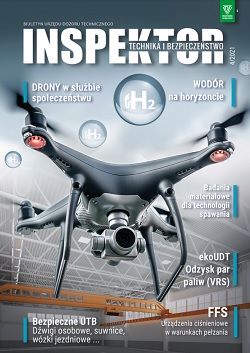
- Are we innovative? (4)
- Hydrogen - green gold. Fuel cells or electricity from hydrogen (7)
Hydrogen fuel cells can be used for a wide range of applications, providing energy for applications in many sectors including transport, industrial, commercial, residential buildings and long-term energy storage for grid in reversible systems.
- Research on VRS systems at petrol stations (12)
Concern for the climate and health of citizens means that we strive to reduce the emission of harmful substances into the atmosphere, both in the interest of and in the fight against climate change on earth. Such harmful substances are, among others hydrocarbons contained in fuel vapors released during the filling or unloading of tankers for the transport of dangerous goods or during the refueling of cars at petrol stations.
- Drones in the service of safety (14)
The most modern research methods, such as acoustic emission or impulse eddy currents, have become commonplace in engineering practice. The directions of research development are aimed at supporting them through innovative techniques that often complement or even replace human work. The Office of Technical Inspection is still developing a fleet of drones designed to work in confined spaces or at heights. It can be clearly stated that nowadays drones have become a tool used to ensure public safety.
- Risk-Based Inspection - part 3 - Modeling the consequences of COF failure (17)
Thanks to the implementation of an effective RBI Program, a tool for continuous improvement of maintenance and systematic reduction of the risk related to damage to pressure equipment in industrial installations has been developed.
- Fitness for Service - Creep Reactor Assessment (22)
In Inspektor. Safety Technique 2/2021 an article was published entitled "Assessment of the impact of damage on the operational safety of pressure equipment. Introduction to the fitness for service methodology ”. The material introduced the subject of fitness for service. This article presents the methodology of fitness for service assessment on the example of a device operating in creep conditions.
- Safe operation of overhead cranes - technical conditions (27)
A gantry crane is an intermittent crane, consisting of a carrying structure moving along the tracks and a winch or a hoist moving along the tracks. It is used for lifting loads vertically and horizontally in the space limited by the lifting height, extreme positions of the winch or hoist travel path and the crane.
- Comprehensive solutions from a single source - Jungheinrich responds to the challenges of Logistics 4.0. (33)
- Assessment of the technical condition of handling equipment - part 5 (36)
A year ago, we started the series of articles by defining the concept of RESURSU in line with the issue of the age and usability of the equipment in use. When the device reaches its service life, it is helpful to assess the technical condition of the device. The activities carried out as part of it allow the device to be qualified for possible renovation, modernization, replacement or, in extreme cases, for scrapping. Subsequent studies concerned individual stages of the assessment of the technical condition of the load-bearing structures of handling devices. In this part of the series of articles, the method supporting the selection of sites for NDT tests and other elements of technical condition assessment, such as corrosion, permanent deformations or places of stress concentration, will be discussed.
- Correct selection of a lift installation in an existing building - easy or difficult? Expertise - part 1/2 (41)
In many residential buildings, lifts are installed that were made according to the old technical requirements. One way to increase the level of safety and reduce energy consumption is to install a new lift in an existing shaft. There are at least two ways to approach the issue.
- ZBUD creates modern solutions for short-distance transport…. Together with the EUDT portal (44)
The overriding goal of the company's activity is to strengthen its market position in the field of material handling equipment.
- The influence of DELTA ferrite on the properties of austenitic steels (48)
Undoubtedly, the commonly used advantages of austenitic stainless steels include their resistance to corrosion and high and low temperatures, durability and effective appearance. The austenitic solids contain a greater or lesser proportion of delta ferrite in the structure.
- European regulations for pressure equipment (PED) (52)
This study presents the PN-EN 13121 standard harmonized with Directive 2014/68 / EU of the European Parliament and of the Council of 15 May 2014 on the harmonization of the laws of the Member States relating to in the pressure equipment market of tanks made of glass-fiber reinforced plastics.
- Changes in the legal environment of the Office of Technical Inspection (56)
- Remote training - specific qualifications (58)
- Events (60)
UDT Inspektor (TIA Inspector) - the whole list







